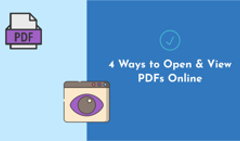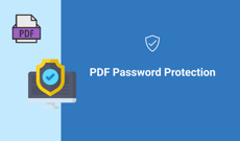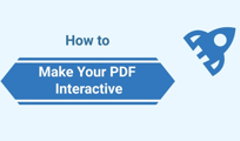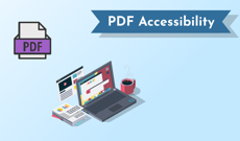There’s no denying it: PDFs are a staple in our daily routine. From proposals to contracts, PDF is often the go-to format used to communicate information to clients, partners, and colleagues. But have you ever wondered what happens to your files when they go out in the world? Are people actually reading your PDFs, or do the documents get lost in the depth of their inbox?
By default, PDFs don’t come with tracking capabilities. Once you hit ‘Send’ or post the file somewhere, you basically lose control over it. In a world where everything and anything seems to be tracked, isn’t that a little strange? Well, the good news is, there is a wealth of different software that does the job. And you can even turn your PDF into an online document—like a digital flipbook—which is much easier to share and track.
When you monitor PDFs, you gain insight into how far they’re spreading and can set up protective measures to contain their reach. Not only does tracking improve file security, but it also provides behavioral data that is invaluable for marketing and sales. Among other parameters, you can discover who viewed and opened the file, what links they clicked on, and what pages grabbed their attention the most.
In this guide, we’ll explore the concept of content tracking and see how it lets you unlock the full potential of your PDFs.
Why You Need to Track PDF Files
PDFs have been around for a while and continue to be a top choice among formats for exchanging information. Employee handbooks, financial statements, legal briefs, product brochures, case studies, and design mockups are just a few examples of content you would send as a PDF file. Utilizing document tracking within them contributes to three core goals:
- Adjust sales tactics
Let’s say you have a PDF that you want to share with a single person: a special offer for a prospect. If you knew the lead hasn’t opened your document, after a few days, you could reach out and encourage them to take a look. Knowing whether or not your clients have read your proposals can help you gauge their interest and follow up at the right moment.
- Ensure data security
Alternatively, If you’re sharing an internal financial report with a team member and notice an unreasonably high amount of views, this could mean your PDF has been compromised and somehow ended up in the wrong hands. More and more employees are working remotely today, accessing files from vulnerable home networks without using a VPN. Tracking PDFs is essential to compensate for the higher risk of security breaches and phishing attempts.
- Improve marketing efforts
PDF catalogs and promotions are a common tool among marketers. And just like with ads, social media, websites, or other content channels, knowing how well they perform is crucial for finding a winning strategy. Tracking could show which campaigns bring the most opens and views, what products and topics are being clicked on—i.e., what truly resonates with your audience.
PDF Tracker Software: An Overview
PDF tracking requires two things: something to distinguish one document from another, like a unique identifier, and instructions on how to ‘phone home’—send the information back to you when a person interacts with the file. All tracking methods are similar in that underlying principle. They keep the content of your PDF, but make subtle changes to its code or format.
![]()
Tools From Adobe
🔹 When to choose: You need to track PDF reviews as a part of an internal workflow, or have to collect signatures from clients.
🔹 Pros: As credible and native as can be since they come from Adobe.
🔹 Cons: Very specific, and therefore limited, in their application.
First, there is Adobe Document Cloud, a virtual storage for PDFs. It’s geared toward document approval: you can initiate reviews, invite people to comment on your PDFs, and add deadlines. You’ll receive notifications when people open, view, or comment on files, but that can hardly be useful for sharing PDFs on your public channels.
A second instrument from Adobe that can track files is called Adobe Acrobat Sign. It will keep you updated on the status of your documents in terms of electronic signatures. You’ll see which PDFs have been sent, signed, or are still pending a signature.
Tools From Google
🔹 When to choose: You’re well-versed in the intricacies of Google’s digital marketing analytics and want to monitor PDF downloads from the same instrument you use for your website.
🔹 Pros: Let you assess how often people download PDFs from your website.
🔹 Cons: The process requires technical expertise and can be quite cumbersome. You can’t track PDF opens or views.
It’s possible to set up PDF tracking with Google Analytics, Google Ads, or Google Tag Manager. There are plenty of step-by-step instructions and guides on the web. Basically, you would create triggers that count the frequency of a specific event: PDF downloads. You can then compare the numbers to see which documents appear to be more attractive.
Document Management Systems
🔹 When to choose: You’re an established business dealing with lots of contracts or other types of documents, and need to keep your files and their statuses in order.
🔹 Pros: Provide a unified database for large volumes of PDFs. Offer additional features like project management, version control, or workflow templates.
🔹 Cons: Have higher prices than standalone tracking solutions.
A document management system like Microsoft SharePoint or Dropbox Business stores PDFs and organizes the workflow around them. The solution can be cloud-based or keep the files restricted to your company network. Tracking comes as a built-in feature, allowing you to see who opened the document, when they closed it, whether the file is lacking a signature, etc. This works both for documents exchanged within your team and with customers.
Tools That Turn PDFs Into Digital Flipbooks
🔹 When to choose: You create PDFs for the purposes of marketing, sales, or internal communications.
🔹 Pros: Are easy to use and can track more parameters than any other tools. Documents load faster and adapt to the viewer’s device.
🔹 Cons: Might not be convenient for a daily flow of standard legal documents or financial statements.
The final tracking option is to turn your documents into flipbooks—HTML5 publications—using a dedicated web service, like FlippingBook. You upload your PDF, and it becomes its own webpage with a fixed address. Built-in marketing analytics tools can now monitor various user actions and engagement metrics for the ex-PDF, the same way tracking works for regular websites.
The three methods mentioned above do not alleviate the limitations of the PDF format itself. Files are usually heavy, so they will take time to load. They do not allow for much interactivity beyond hyperlinks and bookmarks. By turning your PDF into a flipbook, you’ll not only achieve your tracking goals, but also make the document more appealing, protect it better, and easily share it with clients, colleagues, or on social media.
Best Practices for Document Tracking
Before you dive into monitoring your PDFs, it's important to consider some general best practices to make the most out of your tracking efforts. Here are three tips to keep in mind:
1. Use additional measures to protect sensitive data
Leaks of confidential data can do serious reputational damage and lead to legal disputes. You also have the misuse of your intellectual property to think about. People could simply convert the file to a different format and distribute it further. So if privacy is an issue, don’t just track PDF documents, enforce other protective measures. Restrict print and download options, prevent indexing, add watermarks, or disable text copying to keep your content safe.
2. Create concise PDFs for easy interpretation
When you track PDF engagement, the numbers you get won’t always be self-explanatory. For instance, if a file showcases different products, it's best to create separate pages for each one. Otherwise, you won’t be able to confidently say which offer was more popular. By sticking to a structure and using clear headings and CTAs, you can get more accurate insights into your audience's preferences.
3. Analyze your data and take action
Gathering statistics on how your documents perform is only half the battle. Analyze the data: compare different strategies, test hypotheses, prioritize ideas, and introduce changes. Identify areas for improvement, as well as layouts and products that drive better engagement. The content monitoring process doesn’t ever stop, because what worked yesterday might not bring the same results tomorrow. So don’t let your tracking process be static, only focusing on how to track PDF views.
How to Start Tracking Your PDFs With FlippingBook
FlippingBook is one of the platforms that enables PDF tracking by taking your documents online, like in the final method we covered. Here’s how it works:
#1 Sign up for a free trial. Upload a PDF file—it becomes a flipbook that looks the same as your PDF, but has its own web address and the added page-flip animation.
#2 Brand your document and make it interactive. Give your PDFs the look that would resemble your brand: add a logo, a favicon, and brand colors. Flipbooks also support videos, pop-up images, and GIFs. Audiences find digital content 73% more engaging than static PDFs, so use the extra features to boost content interaction.
#3 Share the flipbook. Send it to someone as a direct link or post as a preview on your social media. As for content protection, you can require a password, disable the options to print, share, and download the file, or restrict it to work only on a website page of your choice.
#4 Track performance. You don’t have to set anything up: tracking starts automatically once the document is live. You’ll have a convenient dashboard with all the stats in one place:
- Views and visitors—track views and unique visitors together for a more accurate picture of what’s going on with the file.
- Page views—see how many unique visitors and views a specific page got.
- Time spent—learn which pages were the most engaging, judging by the time people spent on them.
- Clicks—track logo, CTA, and link clicks.
- Shares—monitor content impressions: how many readers found your flipbook share-worthy.
- Downloads and Prints—keep an eye on how the original PDF file is distributed.
- Devices—learn where your audience is coming from and optimize your content to their needs.
- Search queries—analyze what people expect to find in your documents and add the missing pieces.
- Personal data (through a customizable lead form)—ask the reader for any data: email, phone number, name, age, etc.
You can also create individual tracking links and receive email notifications when a lead opens the document, when they print or download the PDF (if allowed), or if they haven’t opened the link by a set date. Use them to track your documents across different marketing channels, or to target prospects and close sales.
Final Thoughts
PDF tracking is not as straightforward as it may seem. While there are tools that can track specific parameters, like downloads or signatures, their application is rather limited, so the best option to monitor PDF performance is to turn your files into digital publications.
Flipbooks offer a range of benefits beyond simply managing to track PDF views, opens, and clicks. Their interactive format increases engagement, and people spend more time reading your documents than they ever would with PDFs. The added features of individual tracking links and customizable lead forms allow you to craft personalized marketing campaigns or sales pitches for impressive results.




